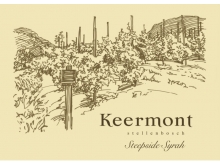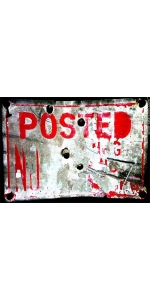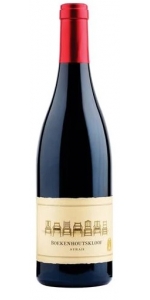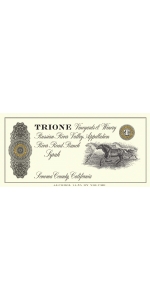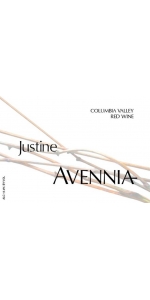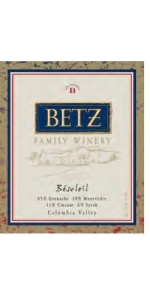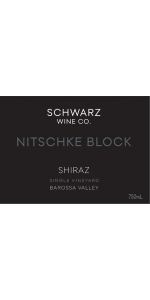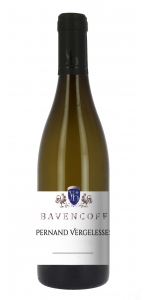Keermont Steepside Syrah 2016
| Country: | South Africa |
| Region: | Stellenbosch |
| Winery: | Keermont Vineyards |
| Grape Type: | Syrah |
| Organic: | Yes |
| Vintage: | 2016 |
| Bottle Size: | 750 ml |
No Syrah terroir in Sonoma County compares with Sonoma Mountain’s northwest crown—cool fog-affected mornings, sun-bathed afternoons, cooled by persistent coastal breezes, and temperate evenings. The soils in Steiner’s Syrah blocks — ashy and moondust-like, littered with decomposing sea bed — further contribute to the unique nature of this site. After a 3-vintage hiatus, I am thrilled to be back working with Steiner Vineyard’s Syrah. By its nature, this slow-to-ripen, cool-climate site produces fabulously deep, intense, structured wines. Now, raising a big, brawny Syrah is no rare act of alchemy. It is the wonder of Steiner’s terroir — a magical elegance and beauty, informing the inherent power, depth and intensity — that makes this bottling so special. 2016 produced a classic wine that deftly balances massive flavors and texture, while retaining vital freshness, and a palpable sense of cool. Production was low, so get it while you can. Simply a “WOW” wine, not to be missed.
VINEYARD: Steiner Vineyard. Located at 1,100 ft, on the northwest crown of Sonoma Mountain. CRUSH: Early morning harvest by hand, October 1st, cluster and berry sorted, destemmed and crushed. FERMENT: 5-day cold soaks, followed by 14 day native fermentation in open-top bins. AGING: 20 months, French oak, 100% new, mixture of 300L hogsheads and barrique shapes. Never racked prior to bottling. Bottled unfined, unfiltered.
Review:
"Refined and stylish, featuring a complex core wrapped in multilayered blackberry and blueberry flavors, laced with bitter chocolate, black licorice and smoky meat notes. Drink now through 2030.- Tim FISH"
- Wine Spectator Insider (January 15th 2020), 93 PTS
Boekenhoutskloof Syrah Swartland is made from 100 percent Syrah.
Grapes for our Boekenhoutskloof Syrah are picked from selected parcels of the finest Syrah, grown at our Swartland farms, namely Porseleinberg and Goldmine, close to the small town of Riebeek-Kasteel. These vineyards were planted on the rocky bedrock of decomposed Mica-Schist, a unique terroir, finding its expression in our concentrated and structured wines made from this Rhône grape.
The nose is perfumed, forthcoming and fresh, offering an array of rich dark fruits with a spicy, floral, even feral character, derived from complex aromas of dark berries, plums, violets, black olives, star anise and potting soil. The black fruits and earthy character of the nose follow through onto a dark, brooding palate with flavours of wild berries, brambles, liquorice, tobacco, cloves and black cardamom. The mid-palate is concentrated, deep, dense and slightly dusty, with dry, very fine cocoa-powdery tannins lending structure. The wine is very precise, with a medium to full body, a tight, grainy texture and vibrant acidity to balance. Blackberries, blueberries and notes of garrigue and dark chocolate linger on a savoury finish.
Review:
Using fruit from two exceptional Swartland sources – Goldmine and mostly Porseleinberg – this foudre-aged Syrah is fresh, subtle and intensely aromatic, as schist Syrahs often tend to be. Complex, floral and refined with remarkable freshness and palate length. Drink: 2020-2028.
– Tim Atkin MW, 95/100
The epitome of cool climate Syrah. Intense and inviting, earthy, peaty but with concentrated fruit flavors of plums, blackberries, blueberries and black cherry all mixed together. Savory yet sweet, this wine just lingers on the palate. Paired with a rich lamb stew, smoked meats or your favorite Fall holiday meal, this wine will shine and develop beautifully for the next 5-7 years.
Review:
"This is a full-bodied Pinot, with rose petal and cinnamon peeking out of underbrush. It's savory, rich, and spicy, with an earthy finish."
- The Tasting Panel (March 2021), 93 pts
"A rich, layered pinot with strawberry, meat, cedar and smoke aromas and flavors. It’s full-bodied and rich, yet remains focused and bright at the end. Drink or hold."
- James Suckling (December 2020), 93 pts
Avennia Justine Red Blend 56% Grenache, 31% Mourvèdre, 13% Syrah
Justine reflects our belief that Washington is capable of producing world class blends of grape varieties traditional to the Southern Rhone region of France. The name is inspired by one of the great heroines of recent literature, who also sprung from the imagination of the Mediterranean. Dark, seductive, complex, with a chasm of depth: The Justine is a great reflection of Avennia's mission of expression, and Washington's generous terroir.
Tasting Note: Big black cherry, blackberry, hints of orange peel, fresh herbs and loam on the nose. Plush and round on the palate. Dark earthy fruits from the Mourvedre, along with citrus high notes, mountain flowers, jasmine, and savory herbs. Balanced and complex without forgetting its hedonistic roots in the Southern Rhone.
Review:
A blend of 56% Grenache, 31% Mourvèdre, 13% Syrah brought up all in older oak, the 2016 Justine offers a great core of black fruits as well as lots of peppery herbs, earth, and classic meatiness. It looks to be a great vintage for this cuvée."
- Jeb Dunnuck (April 2018), 92-94 pts
Betz Family Besoleil is made from 55% Grenache, 23% Mourvèdre, 11% Syrah and the rest Cinsault,
Grenache speaks loudly in the Bésoleil with notes of pomegranate, red raspberry, and strawberry leaf. The Counoise and Cinsualt bring bing cherry fruit and blueberry notes to the table, complicated by pepper and garrique. Mourvedre donates a wild meatiness to the blend, and a purple hue. Syrah rounds things out, adding texture, and flesh to the palate.
Review:
"Attractively complex aromas of cherries, kirsch, white pepper, spice, potpourri and licorice, it's medium to full-bodied, sappy and succulent, with velvety structuring tannins and bright acids." 94 pts - Robert Parkers Wine Advocate
"Bright raspberry and red-plum fruits with attractive depth and freshness. This has all you want in a Rhône-style blend. Good depth of flavor and focused structure." 93 pts - James Suckling
"Moving more and more from Olsen Vineyard, which is 20 miles northwest of Red Mountain (where they love working with the grower, who is proactive and responsive), the medium ruby/purple-colored 2016 Besoleil is 55% Grenache, 23% Mourvèdre, 11% Syrah and the rest Cinsault, all aged in a mix of neutral barrels. It offers beautiful notes of red plums, blueberries, white and black pepper and herbs de Provence, medium to full-bodied richness, a silky, elegant style, and integrated acidity. It's another beautiful vintage of this wine that will keep for a decade." 92 pts. - Jeb Dunnuck
All older vintage wines have been purchased from a single collectors cellar. Pictures can be requested before shipment.
Keermont Steepside Syrah is made from 100 percent Syrah.
Planted in 2005 on the steep midslopes of the Helderberg Mountain range, Steepside Syrah sits at an elevation of 300m. Vines grow in rich red clay loam soils with high levels of iron and quartzite originating from the peaks above. The combination of these deep granitic soils and the intensity of the sunshine on the North facing ridge allows the vineyard to produce wines with power and structure, while the spicy herbal aromatics can be attributed to the elevation and the pristine fynbos flora that surround it.
This is an intense wine with a bright scarlet color. Pure grapey aromas are complimented by red spices, herbs and lavender. The palate has a gentle entry with subtle spicy fruit flavors filling the mid palate. The tight structure gives the wine a succulent dry finish with lingering flavors of red fruit, anise, liquorice and a mineral saltiness.
All grapes used in producing our wines are grown on Keermont Vineyards. Small parcels of grapes are selected according to optimal ripeness and harvested by hand. The grapes are vinified gently and naturally following traditional techniques.
Pair with game or venison. Although any red meat works well.
Review:
"This world-class Syrah hails from a 0.7-hectare parcel planted on a ridge in 2005. Made with no stems in 2016 – the wine normally sees 15% whole bunches - it's like a Cape Côte Rôtie, all perfume, nuance and texture, with notes of ginger spice, barbecued meat and some ferrous grip. 2021-28"
- Tim Atkin (South Africa 2020 Report), 95 pts
The Keermont Estate and Vineyards
Located just beyond Stellenbosch, Keermont Vineyards is nestled in farm land in the beautiful valleys of South Africa. Keermont uses their name to honor the former farm, Keerweder, that once occupied their land. The word “keerweder” means a dead end in a valley. The literal translation is “blocked again”, which is in reference to the early settlers being blocked by the terrain when trying to pass through the valley.
The Keermont winery building and vineyards actually lie in the shadow of Guardian Peak, or “Suurberg”. This location is ideal for Keermont, as the fruit on this mountain is often compared to the grapes of Napa Valley’s famous Howell Mountain AVA.
In 1694, Jan Jac Van Dyk founded the land in the Blaawklippen Valley that is the location of present day Keermont. Other wineries such as Waterford, Dornier, and Stellenzicht are also on the land once owned by Van Dyk. The earliest account of a European landowner utilizing the area for agricultural use are Van Dyk’s records. Afterwards, the potential and beauty of the Blaawklippen Valley attracted many other landowners to the area and the land was divided into individual farms.
Mark and Monica Wraith bought into this land by purchasing the Fleurfontein and Keerweder III farms in 2003. They combined the two farms into the Keermont Vineyards Estate. The couple still live on the Keermont land with their family. Alex Starey is the Keermont winemaker. In 2005, Keermont began a major vineyard planting program and it now holds 27 ha under vine. In 2007, Keermont releases its first vintage, from a crop of only 5 barrels or 108 cases. In 2010, the physical Keermont winery building, complete with offices, processing facilities, barrel rooms, and a tasting room, was converted from the former spring water bottling plant that had once resided on the Fleurfontein farm. The total farm acreage for Keermont Vineyards is 157 hectares or 388 acres, with 27 hectares under vine. 18 hectares produce red varietals such as Cabernet Savignon, Merlot, and Syrah. 9 hectares hold the white varietals like Chenin Blanc, Chardonnay, and Viognier. Keermont also boasts Chenin Blanc vines that are over forty years old and used by De Trafford winery. Keermont aims to create wines that reflect their beautiful land and the particular year’s vintage condition. Keermont focuses on using minimal chemical fertilizers, few pesticides, and irrigate as little as possible. No fining or filtration is practiced on the Keermont Estate. Keermont desires a natural, harmonious vineyard that will in the long run produce better quality wines.
The goal of this estate is to make superior blends. The wines to be produced, but not written in stone, are:
Keermont Red – 40 % Cabernet Sauvignon, 40% Merlot, 20% Syrah.
Keermont White – 70% Chenin Blanc, 30% Viognier and Chardonnay
Dessert wine in exceptional vintages
Keermont Syrah – Syrah, Mourvedre, Viognier
Some wines from Keermont Winery:
- Keermont Red Blend
- Keermont Syrah
- Keermont White Blend Terrasse
Any Keermont wines we have in stock are listed below, if you don’t see the wine you are looking for please don’t hesitate to ask for it.
Schwarz Nitschke Block Shiraz is made from 100 percent Shiraz.
This Bethany vineyard was planted by Jason Schwarz's parents in 1968 and has been tended to by the hands of his family ever since. The vines are dry-grown and produce small crops of intensely flavored fruit.
A display of the purest blood-plum and black cherry, with cracked black peppercorn and streaky bacon over some seriously fine oak. Some subtle herbaceous qualities, nettle and thyme bring life to an otherwise immense nose. Very juicy on the palate, deeply flavorsome, long and with mouth-coating tannin for a very textured, very focused Barossa classic.
Slow cooked beef ribs, grilled meats, wild game and grilled vegetables.
Review:
"All the good stuff: dry-grown and fermented under the aegis of wild yeast; a smattering of whole-bunch seasoning (25%), French oak (20% new), conferring poise, freshness and authority. As far as Barossa shiraz goes, this is benchmark. Plush but nicely taut. A stream of boysenberry fruit and violet scents sashay to a samba of thyme, tapenade and smoked meats, nicely avoiding any sense of reduction, or clunky jam. This is smart. Very. - Ned Goodwin"
- Halliday Wine Companion (August 2020), 96 pts
Bavencoff Pernand Vergelesses Blanc is made from Chardonnay.
The wine offers a white gold or pale yellow color turning into darker gold with age. It boasts aromas of white flowers, (may, acacia) developing into notes of amber, honey and spices. On the palate it is mineral, harmonious and easy to like.
Aged in new oak barrels (Allier).
Sushi, fresh-water fish in white sauce, and for pasta or a seafood risotto.
- back
Ferren Pinot Noir Sonoma Coast is made from 100 percent Pinot Noir.
100% native fermentation (primary and secondary), long cool fermentations often lasting up to a full year, minimal lees stirring, no additions of any kind (commercial yeast, water, acid, enzymes, etc., never any fining or filtration). Aged 18 months in 15% new French oak (Francois Freres, Vosges, Troncais Forrests)
Review:
"This red's pure beam of mulberry, griotte and blood orange pâte de fruit is racy, fresh and in perfect alignment as the flavors pick up dried anise, bergamot and iris accents along the way. Captivating for its combination of range and restraint, with a long, streamlined finish that ripples with subtle tension. Drink now through 2032. - James MOLESWORTH”
- Wine Spectator's insider (May 22nd 2024), 95 pts
#96 - Wine Spectator Top 100 of 2024
Siegel Hand-picked Selection Chardonnay is made from 100 percent Chardonnay.
The handpicked selection Reserva wines are born out of a strong desire to offer the very best expressions of terroir from El Crucero vineyard, located at 360 meters above sea level. These carefully handpicked grapes deliver superb varietal characteristics and exceptionally well-balanced fruit concentration. The manual harvest behind the handpicked Reserva Wines, a stage prior to a second triage, highlights Siegel's commitment to delivering uniquely hancrafted wines from Chile.
This handpicked Chardonnay shows a pale yellow color. On the nose, it presents notes of tropical fruits like mango. On the palate, it is well-balanced, with a pleasant acidity and a persistent finish.
Pairs best with white meats and fish, especially salmon.

